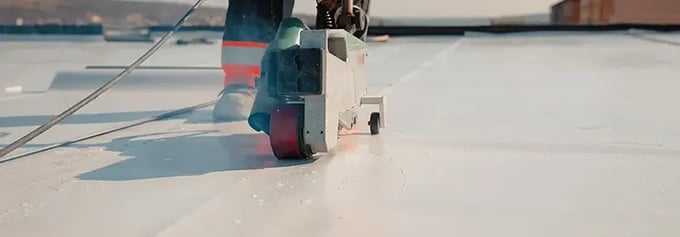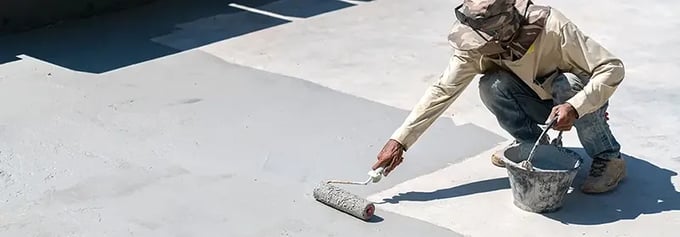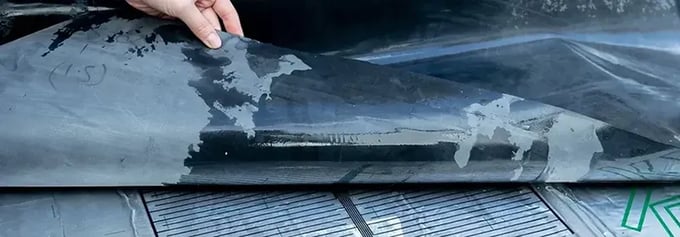Why Medical Facilities Need Smart Water Leak Detection
Water leaks are a very serious problem in healthcare facilities. Learn how these facilities can use smart technology to protect from leaks.
Read our overview of different waterproofing membrane options, how they fail, and how IoT can mitigate these flaws.
Even the best waterproof membrane will fail - so knowing how it can fail is important.
When selecting a waterproofing membrane for a commercial building or facility, you’re balancing several factors. This includes, but is not limited to:
The point is that it’s a complicated process.
We will explore the most popular materials used for waterproofing roofs and walls of commercial buildings. We will examine why these materials are a good choice.
Recognizing that all materials will age and fail, we explain how each usually fails. Additionally, we explain how you can use the Internet of Things (IoT) to reduce the risks and costs of membrane failure.

Thermoplastics are polymers. This type of polymer can be heated and shaped into a desired shape. When cooled, the polymer will re-harden.
This material is waterproof, making it self-sealing. In contrast to other materials, only one layer is needed to waterproof a roof or wall. Additionally, it can be welded into a single sheet which eliminates any gaps or chinks that would allow water to enter.
This type of waterproof membrane is a few kinds of material that are very similar but not identical. The most common are polyvinyl chloride (PVC) and thermoplastic olefin (TPO).
Both PVC and TPO are highly durable, lightweight, and usually very cheap materials. In addition, they are both flame, impact, and corrosion-resistant, making them excellent choices for flat roofs. TPO has a high solar reflectivity. This makes it ideal for cooling a building in hot, sunny weather.
Thermoplastics are also exceptionally long-lived, with the lifespan of a PVC membrane upwards of 60 years.

As great as thermoplastics are, they are not perfect. There are two main drawbacks of thermoplastics:
They are sensitive to heat – thermoplastics are not recommended for buildings in particularly hot climates. The material will melt and deteriorate above 180F (85C). Roofs in the US. can reach temperatures of 150F (65C). This means thermoplastic may not be the best choice for places like Arizona, Florida, and Hawaii.
They have no redundancies – because they are a single layer, if a thermoplastic fails, there is nothing to protect the building if it wears out or cracks.
That last weakness, however, is easily mitigated by IoT sensors. Thermoplastics are probably the best choice for a membrane if you are committed to using IoT technology as part of your building’s infrastructure.
It is possible to bond sensors, like the ones we make at LAIIER, directly onto thermoplastic. This makes them an integrated part of the membrane. This provides extra protection if any part of it starts to deteriorate.
This is also a polymer; like thermoplastics, you can use it to create a seamless waterproof seal for your building. Polyurethane usually comes as a liquid and is applied by spraying or painting it across a surface. This makes it great for sticking to the most common wall or roof surfaces, like concrete, stone, cement or plasterboard.
One key advantage it has over other membrane materials is that you can control how thick it is. As a result, you can achieve a waterproof coating with as little as 2mm. This makes it straightforward and quick to apply vs. other materials and easy to tailor to suit the specific needs of your building.
Polyurethane has a reputation for most often failing due to improper application. It is critical that it be installed correctly, on a dry, clean surface, with the correct ratios for each coat, and allowed to set, dry and cure to be effective.
It can take up to 48 hours to dry paint completely. Curing the paint properly may take up to a week. These times can be further extended depending on the situation.
You must use a quality product. There is a lot of cheap polyurethane available, but it breaks down easily under ultraviolet light.
It is also only likely to last around ten years before sunlight and weather do eventually cause it to break down and warp, at which point, you’ll likely find it starts to fail very quickly.
IoT technology can be used by deploying the sensors under the polyurethane coats in areas where it is most likely to warp or wear out, giving you an early warning if the material is imminently about to fail rapidly.
Bituminous membranes are perhaps the common type of waterproofing membrane used on buildings. These membranes are primarily made of asphalt, modified with polymers, stabilizers and reinforcing materials like fiberglass or polyester.
This makes it very durable and is an excellent choice if used to waterproof a roof where you expect lots of people to be walking. It is also highly resistant to UV radiation and is able to withstand extreme temperatures. Bituminous membranes are also very easy to install and can be used on a variety of surfaces.
This makes them perfect for large projects such as large commercial buildings. Additionally, bituminous membranes are relatively inexpensive compared to some of the other waterproofing materials available. However, it does require regular maintenance and periodic inspections to ensure it has not been damaged by water or other elements.s also possibly the most affordable material to waterproof your building.
They usually come in rolls, making it exceptionally easy to deploy them over a roof surface. They are typically installed in multiple layers and can be adhered to or applied using a torch.
Bituminous membranes tend to be relatively short-lived, only about ten years, and it’s reasonable to expect minor problems to appear before that. They also need to be applied in multiple layers to be durable – a single ply of this kind of membrane is not very durable and may break down easily. They also require extra coatings to make them UV resistant. Otherwise, they melt and degrade more readily than other membrane materials.
Multi-ply layers are often needed for these kinds of membranes. Unfortunately, they can degrade over time. IoT sensors can be installed between the roof layers to help pinpoint where water is entering. This is much more effective than using bituminous membranes.

Ethylene Propylene Diene Monomer (EPDM) rubber is a synthetic rubber known for its high tensile strength and resistance to tearing or cracking. Like thermoplastics, it’s also one of the most long-lasting materials you can use as a waterproof membrane, with a lifespan of at least 50 years.
As you might imagine, EPDM’s most significant advantage is its flexibility, with claims that it will hold its original position through years of heating, cooling and the weight of people or heavy equipment going over it, making it an excellent choice for flat roof waterproofing.
EPDM rubber is not without its weaknesses. It is more vulnerable to punctures and impacts than other materials. If it gets damaged by debris or even someone walking over it in inappropriate footwear, you will need to make repairs quickly to avoid water damage. This also means it needs regular inspections and maintenance.
Consider EPDM rubber carefully. It is not the best choice for achieving water tightness around fixtures, such as vents, chimneys, lights, and HVAC infrastructure. Consider a different material if your roof has many fixtures requiring a lot of cutting of the rubber to fit. The difficulty of installation will make it an expensive choice.
Water detection sensors can be placed under the rubber. They should be positioned around edges or near flashing, as these are areas where water is most likely to leak. IoT technology can help you monitor rubber consistently with proper installation. This makes maintaining rubber easier.

Cementitious waterproofing uses a cement-based polymer coating. It is applied as a liquid epoxy or latex mix to give a single, hard, durable seal when fully cured.
It is a particularly good choice for protecting concrete. Although we haven’t featured it in this article, it is a common choice for waterproofing building foundations, as well as roofs and walls. This makes it a great choice for buildings in coastal areas or those with a high water table (such as Dubai). It is also easy to apply on any angled surface, making it viable for almost any roof shape.
Cementitious coatings are known for their strength, durability, and ability to resist abrasion, impact and chemical damage. They are also resistant to UV radiation and can be used outside and within a building. They are also known for their resistance to mold and mildew.
One disadvantage of cementitious coatings is that they are not as flexible as other waterproofing materials. They are more prone to cracking in areas with significant movement or settling, just like the concrete it is often protecting. Additionally, cementitious coatings can be more complex and time-consuming than other waterproofing systems.
These waterproofing membranes also present a challenge in terms of IoT solutions. Unlike other materials, there’s no layer or material you can put sensors between or within. In this case, there has been development in using sensors that focus on the structural health monitoring of the concrete rather than trying to detect points where water might leak in.
Waterproof membrane failure is a complex and challenging problem that can have severe consequences for the longevity and safety of a building. Every material you can use has its pros and cons. That said, in the long-term, there is a clear case for using more long-lived, better-quality materials. It is not a coincidence that these options can also make better use of the Internet of Things.
IoT technology, including the products we make at LAIIER, are almost all focused on improving the efficiency, effectiveness, and longevity of our built environments. They are best supported by choices in materials and structures that also favor longevity and efficacy.
Experts and the right tools can reduce the chances of a waterproofing system failing. This ensures that a building's waterproofing system will be effective over a long period of time. Do you want to take this direction for your building projects and developments? We'd love to talk to you and find out if LAIIER can help you reach your goals.
Water leaks are a very serious problem in healthcare facilities. Learn how these facilities can use smart technology to protect from leaks.
Your building’s water infrastructure is prone to leaks. Understand which factors influence how and why water leaks occur.
Taking a closer look at the different types of water damage that affects commercial properties, the impact, and how smart sensing technologies can...
Subscribe to receive our latest news and updates.